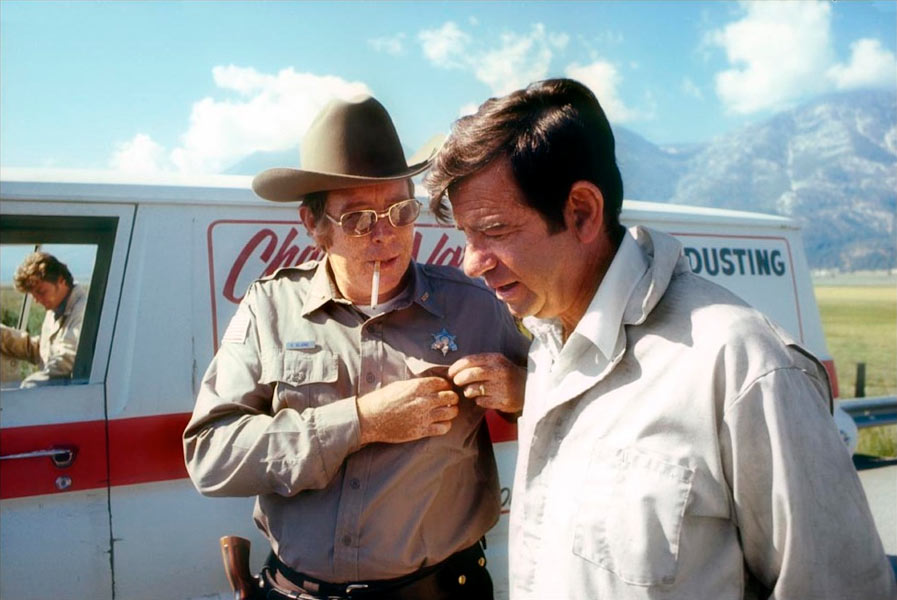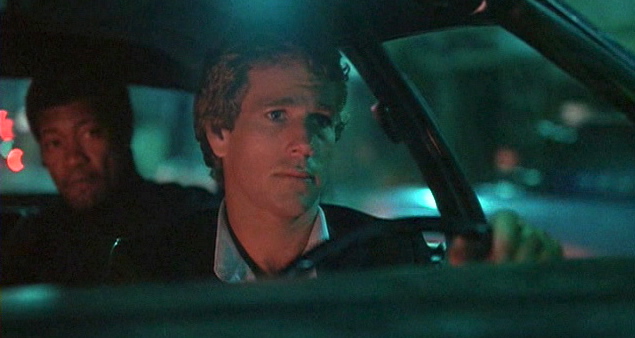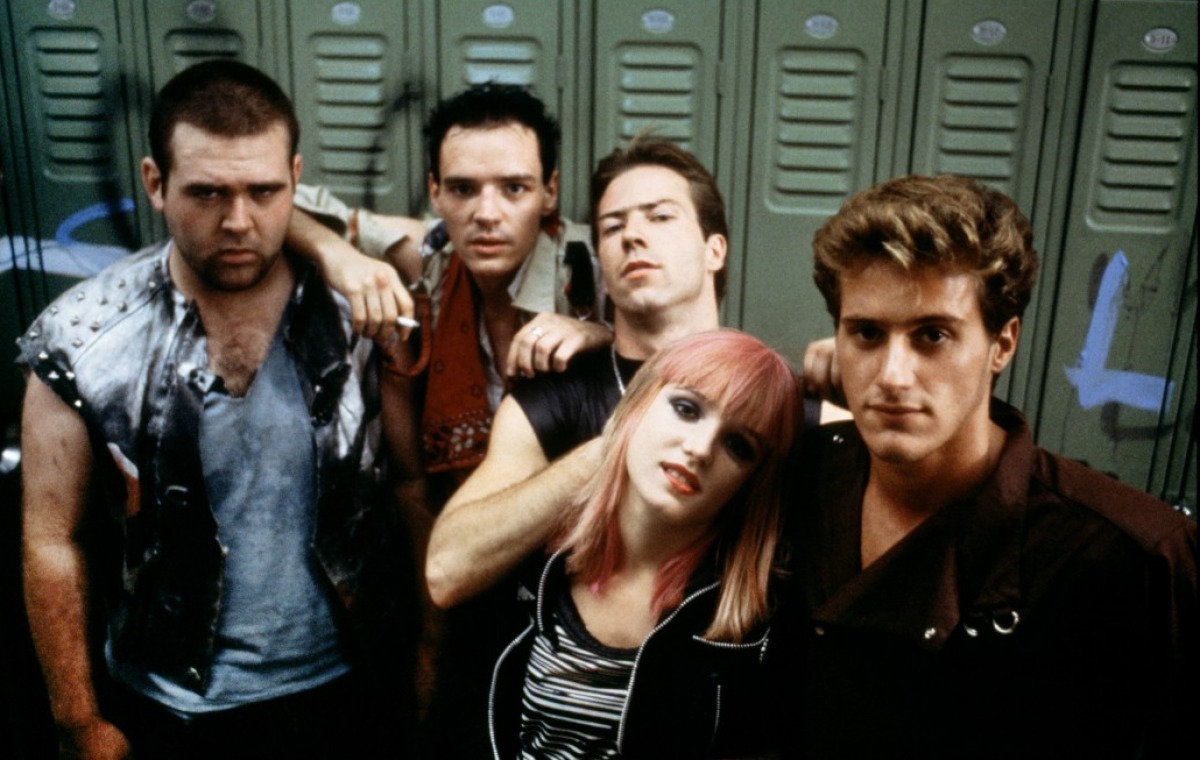9. Bloody Mama (1970)

“You gotta’ believe… You gotta’ have faith… But first, you gotta’ get rid of the witnesses” [17]. This is a Roger Corman produced film based upon the real life Ma Barker and her gang of sadistic and perverted sons who robbed banks during the depression era. It was an attempt by Corman to piggyback off the success of Bonnie and Clyde and contains a ton of murder, violence, sexual situations, and a violent bullet filled ending.
The film stands out for having extreme violence, decent action, decent sets and period look, and the appearances of Shelley Winters and Robert DeNiro.
The film was important for DeNiro for two reasons, it was his first role in a major studio film and it was the first time that his method style of acting had “surprised and impressed his co stars” [18]. He played the drug addicted Lloyd Barker, losing 40 pounds and cutting scabs in his face in order to make himself look more like a drug addict [18]. In his death scene inside a grave, he laid down in the dirt before shooting in order “to get the feel of a dead man” [18].
10. The Harder They Come (1972)

This is a Jamaican crime film that is said to be most famous for its reggae soundtrack and bringing reggae to the world; it is also the most influential Jamaican film to be made.
Jimmy Cliff plays Ivan, a country boy who goes to the city in order to try and become a big reggae star. He makes a record but gets screwed over by the record producer. He ends up getting involved in the drug trade, becoming a local dealer, and killing some police. The cops try to hunt him down and his record climbs the charts due to his criminal notoriety. He sees Django in a theater earlier in the movie and the police battle at the end recreates that, with the audience howling and cheering.
The film did well in the U.S. at midnight showings in the 1970’s. Its soundtrack is actually probably more popular than the movie; it was considered a breakthrough for reggae in the United States [19]. The soundtrack featured Cliff, Desmond Dekker, and Toots and the Maytels, and included the standard songs “Sitting in Limbo,” “Many Rivers to Cross,” “Pressure Drop,” and “The Harder They Come.”
11. Charley Varrick (1973)

“When he runs out of dumb luck he always has genius to fall back on!” [20]. Charlie (Walter Matthau), his wife, and two accomplices rob a New Mexico bank and things go wrong and they kill police and end up with several bags of money. They expect around $20,000, but soon discover that they have much more than that and it’s the mafia’s money.
The president of the bank only reports $2,000 was stolen and sends out a hitman to recover the stolen money. They must come up with a plan to escape and throw the mob off of their trail.
The film is one of those gems that sadly got missed or left behind and should get brought back into the light. If features excellent directing from Don Siegel, a great bank robbery scene, great script, great acting from Matthau and the supporting cast, it’s fast paced with lots of action, and lots of death.
A critic review says that “Siegel has decorated the movie with a lot of colorful bit characters including a chatty, sex-obsessed old woman, but the action sequences give the film its content as well as style. The duel between a high-powered automobile and an ancient biplane at the end of the movie is what it’s all about” [21].
12. Dillinger (1973)

“…he was the gangster’s gangster” [22]. There are only four reasons that should have to be given for this to be considered a great and must watch movie; it’s about John Dillinger, it stars Warren Oates as Dillinger, it also stars Ben Johnson as the FBI agent Melvin Purvis, and it was written and directed by John Milius.
This film is great and even though it came out after Bonnie and Clyde, it isn’t the same type of characters or story. Bonnie and Clyde was a romanticized film about gangsters and a couple in love, while Dillinger is a tough guy being hunted down by the kill first Purvis. Oates doesn’t just play Dillinger; his personality is Dillinger and it’s one of his best performances.
Milius said that he had wanted Oates to play the lead in The Life and Times of Judge Roy Bean and he said “”I write all my things for Warren Oates or young John Wayne types, or sometimes Clint Eastwood. He looks good holding a gun. But to me John Wayne is the ultimate American hero. Not because he’s big and tough but because he’s sentimental. My pictures are sentimental, idealistic. I deal with values of friendliness and courtliness and the family and chivalry and honor and courage – not just guts but bigger than life courage. Nobody today writes movies in the style that I do. Nobody. I write characters that are strong and direct, super individuals. The people in my movies fear no one but God” [23].
John Milius is a gifted screenwriter and director, who has a unique ability to create great dialogue and situations in the stories that he creates. He provided the dialogue to the major boat scene for Jaws over the phone with Steven Spielberg, wrote Apocalypse Now, and directed Conan the barbarian, among many other screenwriting and directing credits.
13. The Candy Snatchers (1973)

A trio of criminals kidnap a teenager named Candy and bury her alive while they attempt to extort jewelry from her father, while an autistic boy that cannot speak and lives in a dysfunctional family is the only witness to the crime. Things from there go on a series of surprising double crosses and shocking plot twists that won’t be revealed so as not to spoil anything. But the ending is very memorable and could be considered extremely shocking.
This is an unbelievably excellent exploitation movie that has been somehow missed. It is a brilliantly filmed low budget film featuring a solid script and dialogue, great cinematography, great use of color and shadows, and great acting from the overall cast.
Vince Martorano particularly stood out as the criminal Eddie, who tries to protect Candy from being harmed by the rest of his group. It is a violent, dark, and sleazy world that features multiple evil characters, rape, and murder. It could be considered as a neo-noir film, being as it’s a dark story where bad things usually happen to everyone.
The film could be seen as influencing both Quentin Tarantino and David Lynch and their future films. It has parts that could be related to Reservoir Dogs, including the jewel heist, the shoot out gone bad, and an ear being cut off. It has elements that could relate to Lynch’s Twin Peaks series, mainly the highly dysfunctional family and the mother that is very mean and crazy. This film is truly a must see for fans of crime thrillers, it is truly disturbing on multiple levels.
14. Gone in 60 Seconds (1974)

“You can lock your car. But if he wants it…it’s GONE IN 60 SECONDS” [24] Before there was Angelina Jolie and Nicholas Cage stealing 48 cars in the 2000 version of Gone in 60 Seconds, there was the not so Hollywood original that was released in 1974.
It was written, produced, directed, and stars H.B. Halicki who also did most of the stunt driving. Halicki stars as Maindrian Pace, an insurance investigator that also happens to steal cars. He makes a deal with a South American drug lord to steal 48 specific cars for him, all to be delivered to the Long Beach docks within five days. Pace’s only rule is that all of the stolen cars must be insured.
Like the remake, all of the cars have female code names to mask their illegal scheme. Problems and disputes between the thieves come to a head way when one of them calls in a tip to the police on where the final car will be stolen from. That final car is a 1973 black and gold Ford Mustang code named “Eleanor.” Pace steals the car but the cops are there and this leads to a forty minute car chase through six different California cities.
The film is by no step a masterpiece; there was virtually no script, the sound is poor, and the acting is not very good. They pretty much just made up things as they went along and most of the actors were friends and family, in order to save on production costs. What you do end up with is one of the longest and greatest car chase scenes put to film, with somewhere around 93 cars and a garbage truck being destroyed.
There were multiple real accidents that occurred and were luckily captured on camera; including a police car overturning, an actor nearly being hit, and when “Eleanor” gets rear ended and hits a light pole at a speed of 100 mph. The final big climax has “Eleanor” jumping over a series of wrecked cars, covering a height of 30’ and distance of 128’ without the use of a catapult or special effects. Halicki injured himself on the stunt, compressing his spine in the landing [24].
Halicki was killed in 1989 during the preparation for a stunt for a sequel. While this version is nowhere near as slick and glossy as the remake and there are many flaws, this is still essential viewing for fans of car chase scenes.
15. The Driver (1978)

“He’ll get you away faster than anyone else on wheels” [25]. The man known only as the driver (Ryan O’Neal) is good at one thing and that is driving the getaway car for robberies, so far he hasn’t been caught. One obsessed, ego driven cop (Bruce Dern) has been pursuing him and will do anything to catch him, including setting up a real bank robbery with a gang that doesn’t want to go to jail. A cat and mouse type game ensues as the driver performs the bank job and tries to get away without being caught.
This is a cool movie with that was loosely based on the French film Le Samourai; it has good acting from O’Neal and Dern, an interesting title character, several extremely very well done chase scenes, a wild scene where the driver shows his abilities in a parking garage and smashes up a car, and a western style gun fight ending that also has a car chase.
There are similarities between this film and the 2011 film Drive by Nicholas Winding Refn, which was based upon a 2005 novel by James Sallis. The main similarities is that the main character is a driver for crimes and the first chase scene, after that the films both go on different paths with the original focusing on the cop element and the newer on the underworld criminal element.
The first chase scene though is almost identical, it’s a chase through Los Angeles, he’s waiting to pick them up at a specific time, cops chase him, he stays calm, they drive over a bridge, and they try to hide.
16. The Long Good Friday (1980)

“What should have been the greatest day of Harold’s life suddenly becomes the longest” [26]. Harold (Bob Hoskins) is trying to broker a large legitimate deal involving the American mafia and other local parties, when a series of disastrous attacks happen against him and his organization; including the murder of his sidekick, the bombing of one of his pubs, and the explosion of his mom’s chauffeur.
This takes Harold on his own path of destruction as he tries to find out which gang is attacking him, including rounding up local gang bosses and hanging them from meat hooks. He eventually discovers that all of this violence is due to an unknown side deal with the IRA that went bad. He decides to try to exact some vengeance on the IRA and that leads to his demise.
The take on the IRA in this film is one in which they are kind of considered the ultimate gangsters, they win in the end. Their ability to thrive and survive is what makes them more than just simple gangsters, because they are “motivated by a form of political belief that amounts to more than just economic self-interest” [27].
The film has a strong cult following due to the excessive amount of violence that takes place, both against Harold’s gang and also by himself. It is also due to Hoskins performance, which is absolutely superb and one of his best. Hoskins was nominated for a BAFTA for Best Actor in 1982.
17. Class of 1984 (1981)

“Look at us. We are the future. You can’t stop us. Don’t even try” [28]. The opening of the film claims that this film is based upon true events and that in 1980, there were 280,000 incidents of violence committed by students towards teachers. While this claim may be somewhat true, this film isn’t based on actual events but is meant to be a social commentary on the increased violence in schools.
The film is about Andrew Norris (Perry King) who has just started working at a troubled inner city school as their new music teacher. He becomes friends with disenfranchised teacher Terry Corrigan, (Roddy McDowell) who drinks and carries a handgun to school and Norris also has a run in with a gang of students.
The gang is lead by Stegman (Timothy Van Patten), a troubled and talented pianist who is mainly interested in running a drug trade and its many associated splendors. Things get pretty serious as Norris and Stegman battle each other, with dire ramifications for various students, Corrigan, Norris and his wife, and a final showdown between Norris and the gang.
This is movie is a punk rock combination of Clockwork Orange, the Warriors, the Wanderers, Over the Edge, and Death Wish, with a horror finale. The director actually cited Clockwork Orange as the “films biggest influence” [28]. There are excellent performances from King, McDowell, Van Patten, and an early appearance from Michael J. Fox. King is great as the only teacher that is trying to change the system in the school and help the student, but eventually is forced to fight in order to save his wife.
McDowall is great as the teacher who has accepted the way things are, and just tries to get by each day by drinking and carrying his gun. He has one particularly strong scene right after his animals gave been killed, where they hold on him for almost a minute as he struggles and then puts his hand up and says that he is ok. Van Patten is the ultimate bad guy, playing the system and has several great scenes.
The film is relevant for several reasons; it has a theme song from Alice Cooper called “I Am the Future,” it also features an appearance from the punk band Teenage Head, it showed the future of policing at schools with security guards and machines, it predated other films like Lean on Me that dealt with taking back a school, it features an early appearance from Fox, and it had a punk rock anti establishment theme that was relatable to youths.
There were many memorable scenes, in particularly the piano scene which is by far the most brilliant piece of work on this film. Stegman comes into the music class and Norris wants to kick him out, Stegman then sits at the piano and starts to play beautifully and Norris is astounded. It’s the best he’s ever heard from any of his students before, but he still kicks him out of class because of his gang dealings.
Other memorable scenes include the kid climbing up the school flag pole and then falling off, a meeting between Norris and the gang in an alley, when Corrigan’s animals are killed, a pre Fight Club scene where Stegman beats himself up, a prison style shanking in the cafeteria, McDowall’s performance when he is teaching his student s at gunpoint, and the series of gory deaths in the finale.